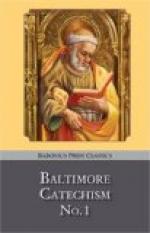157 Q. How many kinds of Baptism are there? A. There are three kinds of Baptism: Baptism of water, of desire, and of blood.
158 Q. What is Baptism of water? A. Baptism of water is that which is given by pouring water on the head of the person to be baptized, and saying at the same time, I baptize thee in the name of the Father, and of the Son, and of the Holy Ghost.
159 Q. What is Baptism of desire? A. Baptism of desire is an ardent wish to receive Baptism, and to do all that God has ordained for our salvation.
“Ardent wish” by one who has no opportunity of being baptized—for no one can baptize himself. He must be sorry for his sins and have the desire of receiving the Baptism of water as soon as he can; just as a person in mortal sin and without a priest to absolve him may, when in danger of death, save his soul from Hell by an act of perfect contrition and the firm resolution of going to confession as soon as possible. Baptism of desire would be useful and necessary if there was no water at hand or no person to baptize; or if the one wishing to be baptized and those about him did not know exactly how Baptism was to be given—which might easily happen in pagan lands. One thing you must especially remember in giving Baptism in case of necessity: namely, that it would not do for one person to pour the water and another to say the words. The same person must do both, or the Baptism will not be valid. If you are called to baptize in case of necessity, be very careful to observe the following points, otherwise the Baptism will not be valid: use clean water and nothing but water—no other liquid would do. Say every one of the exact words: “I baptize thee in the name of the Father, and of the




